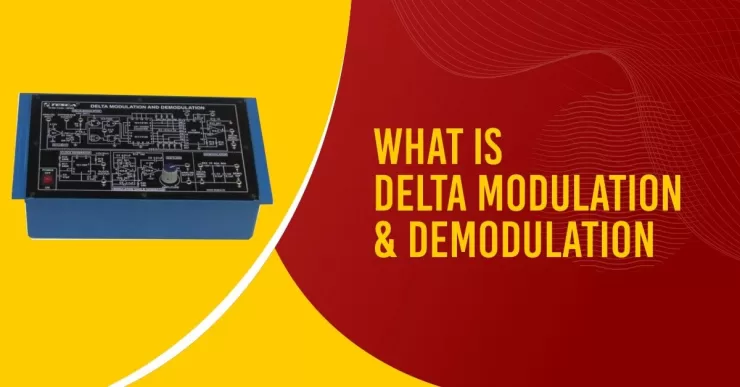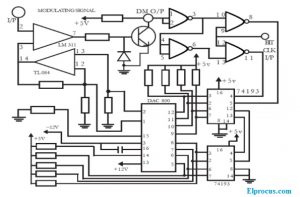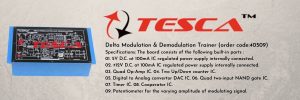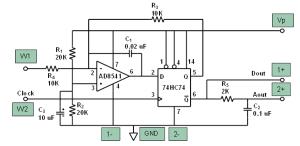Table of Contents
In this article, we will discuss Delta modulation and how it is used as a modulation technique for digital signaling systems. Let’s get started without any ado:
It is a type of modulation where the amplitude of the carrier is varied in response to the instantaneous value of the input signal. In the case of delta modulation, the input signal is a digital signal. It can be regarded as a set of discrete values.
Delta modulation is a straightforward form of modulation. It is used in different digital communication systems.
What is Delta Modulation?
‘The conversion technique wherein the conversion from analog to digital and digital to analog signal is done for the transmission of voice information is known as delta modulation.’
Image Source: watelectronics.com
It doesn’t focus on the quality, and the data can be reduced to the size of a 1-bit data stream.
In this technique, the use of the predictive waveform coding technique is preferred for the conversion of the signal. Differential pulse code modulation increases the sampling rate so that the bandwidth of the signal can be decreased by reducing the number of steps.
Delta modulation is a form of signaling used primarily in data transmission systems. In delta modulation, a new bit is sent using a pulse of constant amplitude and a duration proportional to the value of the bit. The bit rate is constant, and the average power is reduced.
In simple words, it is a type of modulation that uses a PWM signal as a carrier and a digital modulating signal to represent a digital data stream.
Delta modulation in Digital Communication:
Delta modulation is a digital modulation scheme. It is a type of phase-shift keying (PSK), i.e., a digital modulation scheme in which the phase of a reference signal is varied to convey information.
Delta modulation was introduced by John R. Pierce, who also invented video telephony and the FM radio in his 1949 paper “Some novel methods for transmitting the information.” It is a technology that helps increase the speed of communication up to V2V and V2I communication. Using this modulation will help in increasing the speed of communication.
In this technique, the amplitude of the modulating signal is made proportional to the instantaneous value of the desired information signal. This technique allows the transmission of data at a much higher bit rate than an analog carrier wave.
It is used for the transmission of data over the telephone line, satellite link, etc. The object of delta modulation is to transmit a series of digital 1s or 0s at a high bit rate without introducing too much distortion. This is done by converting the message into the form of pulses whose widths represent 1s and 0s.
Delta-Sigma Modulation:
Delta-sigma modulation is a technique of converting an analog signal into a digital one by increasing the sampling rate.
Delta-sigma modulation (DSM) is a method of encoding analog signals into digital form. It uses pulse-width modulation to encode the 1’s and 0’s that make up the signal, so it is different than conventional binary coding, which uses ones and zeros.
Image Source: wiki.analog.com
The advantage of this method is that fewer bits are needed to represent an analog signal, resulting in higher data rates for the same bandwidth.
The main difference between delta-sigma modulation and its predecessor, delta modulation, is that the quantization noise is removed through sigma-delta modulation before the signal is converted to analog. It is one of the most popular methods used for converting information from digital to analog form.
Delta Modulation Applications:
Below mentioned are some of the essential applications of the Delta modulation:
- When it comes to voice transmission systems, Delta modulation is a highly preferred technique. It is a technique that is commonly used for telephone and radio communications.
- Delta Modulation method is generally used for the encoding of signals from analog to PCM.
- It is also applied for signal conversion in television systems.
- One of the most critical applications of this technique is that it is used for real-time Signal Processing and database reduction in the ECG waveform.
- This technique is helpful for the system wherein the data delivery at the receiver is important than its quality.
Delta Modulation Theory:
When we talk about one of the simplest forms of modulation them Delta modulation is the one that is the simplified form of differential pulse code modulation.
Delta modulation is well known for its simplicity because it is used as a simple quantizing strategy for constructing the encoded signals, which are over-sampled purposely, to increase the correlation between adjacent samples of the signal, which are seen in differential pulse code modulation. To increase the correlation of the signal, the sample interval is reduced by the modulation.
It is a process that is mainly used for the transmission of voice information. It is instead a simplified way of differential pulse code modulation (DPCM). This method is used to convert or encode analog signals into digital signals; that’s why it is also known as the game-changer revolution in the field of communication.
The process is to convert the high-bit-count, low-frequency digital signals into lower-bit-count and higher-frequency digital signals wherein the signals are converted into analog as part of a digital-to-analog converter (DAC). There are many methods used in digital signal processing for communication systems, from which some are pulse code modulation, delta modulation, differential pulse code modulation, etc.
The basic principal of this technique has three formulas which are=
1.e(nTs) = m(nTs) – mq (nTs – Ts )
2.eq(nTs) = δ sgn[e(nTs)]
3.mq(nTs) = mq(nTs – Ts) + eq(nTs)
Where the symbol stands for=
m(t)-input signal
mq(t)-staircase approximation
Ts-sampling period
e(nTs)-error signal representing the difference between the present sample value m(nTs) of the input signal and the latest signal. eq(nTs) – quantized version of e(nTs).
The modulation is affected by two types of quantizing errors which are-
- Slope Overload Distortion
- Granular Noise
Slope overload distortion is when step size is too small, and granular noise is when step size is too large. In this modulation method, accommodation of a vast dynamic range is done by the more significant step size, and the accurate representation of low-signals is done by the smaller step size. So for minimizing errors, we should select the optimum step size.
Adaptive Delta Modulation Transmitter and Receiver:
The adaptive Delta modulation technique is one of the subparts or types of Delta modulation that eliminates granular noise error efficiently. The main issue with digital modulation is the determination of the step size, which does influence the quality of the wave through which the production of the output is done.
In the steep slope of the modulation signal, a significant step size, as well as small step size, is required at the time when the message has a slope. The step size should be controlled as per the requirement so that the sample output can be e obtained. This is why adaptive Delta modulation is required in the whole process.
Adaptive Delta Modulation Waveform:
Adaptive delta modulation waveform is an algorithm that produces an efficient decompression without requiring that the original message be encoded with any particular structure. It uses only one bitstream but is robust enough to handle errors in the transmission or storage of the bits.
This means that it can be used as a reliable backup mechanism for other modes of data compression. The adaptive delta modulation waveform is a special case of the general class of delta modulation waveforms. Adaptive delta modulation is used to encode binary symbols onto a continuous-time signal.
It allows variation of the amount of information per unit length of the tape. The system in the Adaptive delta modulation waveform uses a recording medium with an amorphous structure. With this, it can realize a great variety of coding strategies.
Read also: Essential Physics Lab Equipment.
Advantages of Delta Modulation:
In comparison to digital modulation techniques Delta modulation has some advantages that are mentioned below:
- When it comes to lover betrayed, Delta modulation is way better than the standard PCM as the operation of voice signal under Delta modulation system is done under optimum conditions, which increases the SNR by 9 DB and also doubles the bit rate.
- Delta modulation is known for removing the redundancy of the encoded signal quite efficiently in comparison to a PCM sampling rate of PCM that is higher than the Nyquist rate.
- In comparison to PCM, Delta modulation is cost-effective.
- In Delta modulation, the task of transmission of signals is done at lower channel bandwidth which makes shows that it Delivers quick and robust data bits.
- It doesn’t exceed the maximum speech sinusoidal amplitude.
Disadvantages of Delta Modulation:
Some of the Limitations of Delta modulation are as follows:
- The Delta modular doesn’t follow the signal if the signal step size is lesser. By doing so, it produces alternative positive and negative pulses.
- In comparison to other modulators, it has a high bit rate.
- The modular has an average startup response, and the usage of this modulator is limited practically.
- If the signal is too high, then the modulator overloads.
- In comparison to other types of modulators, Delta modulation is rather complex as it requires a predictor.
Delta Modulation Circuit:
A circuit that is used for the production of the output of delta modulation is known as the Delta modulation circuit. In this technique, the modulation information on a carrier wave is done.
The change to encode information on its carrier is minimum in this technique. In Delta modulation, the amplitude modulation determines the magnitude of the analog output with the help of a reference signal and information signal.
Let us assume that the voltage of a delta modulator is zero consistently. If there is any sudden change in the input signal, then the Delta modulator voltage will rise. With the increase of the frequency, the voltage level and the higher frequencies are changed. With the help of the rest R1 and R2 resistors, the voltage level is held back.
Difference between Delta Modulation and Adaptive Delta Modulation:
Here are some significant differences between Delta modulation and adaptive Delta modulation:
- The Delta modulation has a fixed step size for the entire signal, where is in the adaptive Delta modulation, the step size can be changed as per the requirement and variation of the signal.
- Quantization noise is present in adaptive Delta modulation, whereas, in the Delta modulation, the granular noise and overload distortion are present.
- In Delta modulation, the utilization of the bandwidth is not as efficient as the adaptive Delta modulation.
- In comparison to Delta modulation, adaptive Delta modulation has a broader range.
Granular Noise in Delta Modulation:
When the step size of the signal is large in comparison to the variation of the original input of the signal, it produces a granular noise. It is an error that can take place between the approximated signal and the original input half the signal. It is also known as idle noise.
In short, the slight variation of the input signal is changed into a large amount due to the large step size of the signal input. This can be solved by making the step size smaller.
Delta Modulation and Demodulation Theory:
In modulation by adding electronic or optical carrier signals, data is converted into radio waves. Amplification and filtering at different stages are done by the demodulator so that the interference can be eliminated. There are very few factors that are responsible for influencing the extracted information and replicating the original for the input information.
For modulation and demodulation, a modem is the device that is used. In modulation, the information is encoded in a transmitted signal, and in demodulation, the information is decoded in a transmitted signal. The name modem is derived from the combination of the letters modular and demodulator.
With the help of a multiplexer in the combination of streams of a different carrier can be done with the help of and coding the fixed duration segment one and then the other.








Add comment